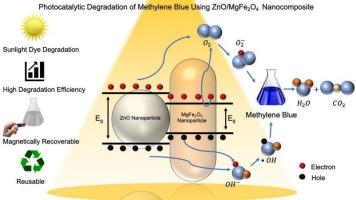ZnO/MgFe2O4纳米复合材料在低频电子和可持续水处理中的结构、磁性、介电和光催化性能
IF 4.6
2区 物理与天体物理
Q2 MATERIALS SCIENCE, MULTIDISCIPLINARY
引用次数: 0
摘要
多功能纳米复合材料在解决新兴问题方面具有重要意义,面临着广泛的科学和技术领域。本文报道了一种简单的合成ZnO/MgFe2O4纳米复合材料(NC)的方法,并对该产品进行了系统的表征。由ZnO和MgFe2O4组成的结构坚固的杂化体系导致各个组分之间的界面协同作用,从而提高了混合材料的整体性能。对合成的纳米复合材料的结构、形态、磁、介电和光电性能进行了深入分析。阻抗分析表明,ZnO/MgFe2O4 NC中的电输运主要由MgFe2O4主导,ZnO对电荷传导的影响可以忽略不计,从而产生了相当的电阻行为。以亚甲基蓝(MB)为模型污染物,考察了ZnO/MgFe2O4在自然光下的光催化活性。结果表明,该方法的去除率为99.16%,显著高于纯MgFe2O4和ZnO纳米颗粒。光催化活性的增强与NC产生更高的光电流、更好的电荷隔离能力和更低的电荷转移电阻有关。这表明ZnO/MgFe2O4 NC光催化剂在可持续降解水中染料方面具有显著的潜力。本文章由计算机程序翻译,如有差异,请以英文原文为准。

Structural, magnetic, dielectric, and photocatalytic properties of ZnO/MgFe2O4 nanocomposite for low-frequency electronic and sustainable water treatment applications
Multifunctional nanocomposite materials have gained a lot of importance for addressing emerging issues, facing a diverse range of science and technological fields. Herein, we report a simple method for the synthesis of ZnO/MgFe2O4 nanocomposite (NC) and a systematic characterization of the product in this study. A structurally robust hybrid system consisting of ZnO and MgFe2O4 leads to interfacial synergy between the individual components, leading to enhanced overall performance from the blended material. An in-depth analysis was conducted to study the synthesized nanocomposite's structural, morphological, magnetic, dielectric, and photoelectric properties. The impedance analysis indicates that the electrical transport in ZnO/MgFe2O4 NC is primarily dominated by MgFe2O4, with ZnO having a negligible impact on charge conduction, resulting in comparable resistive behavior. The photocatalytic activity of the ZnO/MgFe2O4 was evaluated using methylene blue (MB) as the model pollutant under natural sunlight. The results showed a removal efficiency of 99.16%, which was significantly higher than pure MgFe2O4 and ZnO nanoparticles. The enhanced photocatalytic activity was correlated with higher photocurrent generation, better charge isolation ability, and lower charge transfer resistance of the NC. This shows the remarkable potential of ZnO/MgFe2O4 NC photocatalyst for sustainable degradation of dyes from water.
求助全文
通过发布文献求助,成功后即可免费获取论文全文。
去求助
来源期刊

Results in Physics
MATERIALS SCIENCE, MULTIDISCIPLINARYPHYSIC-PHYSICS, MULTIDISCIPLINARY
CiteScore
8.70
自引率
9.40%
发文量
754
审稿时长
50 days
期刊介绍:
Results in Physics is an open access journal offering authors the opportunity to publish in all fundamental and interdisciplinary areas of physics, materials science, and applied physics. Papers of a theoretical, computational, and experimental nature are all welcome. Results in Physics accepts papers that are scientifically sound, technically correct and provide valuable new knowledge to the physics community. Topics such as three-dimensional flow and magnetohydrodynamics are not within the scope of Results in Physics.
Results in Physics welcomes three types of papers:
1. Full research papers
2. Microarticles: very short papers, no longer than two pages. They may consist of a single, but well-described piece of information, such as:
- Data and/or a plot plus a description
- Description of a new method or instrumentation
- Negative results
- Concept or design study
3. Letters to the Editor: Letters discussing a recent article published in Results in Physics are welcome. These are objective, constructive, or educational critiques of papers published in Results in Physics. Accepted letters will be sent to the author of the original paper for a response. Each letter and response is published together. Letters should be received within 8 weeks of the article''s publication. They should not exceed 750 words of text and 10 references.
 求助内容:
求助内容: 应助结果提醒方式:
应助结果提醒方式:


